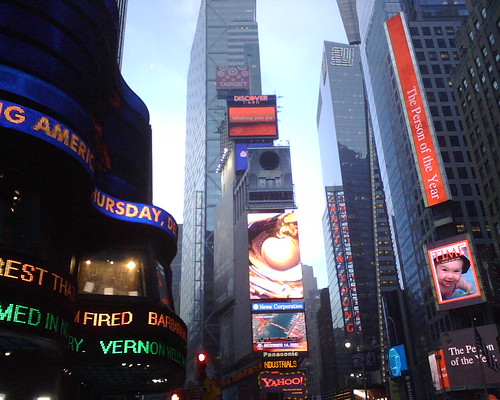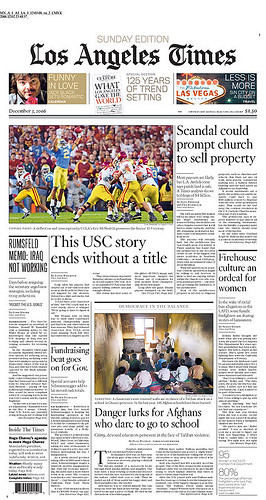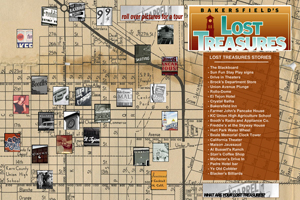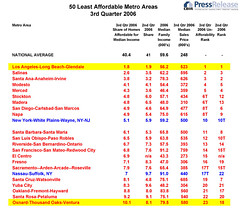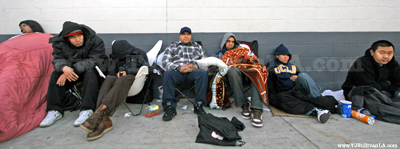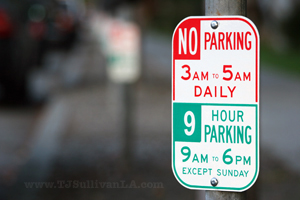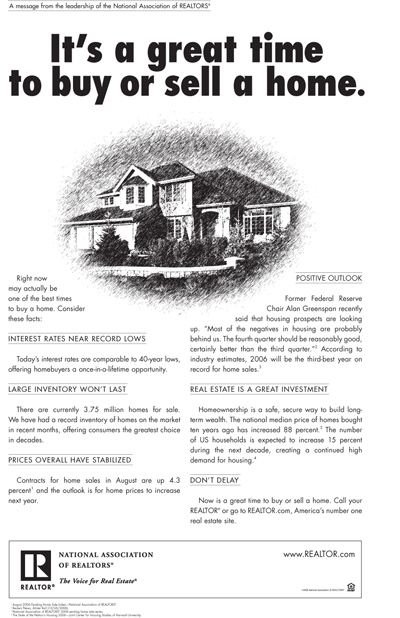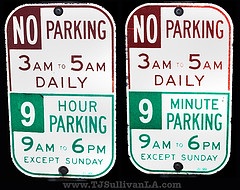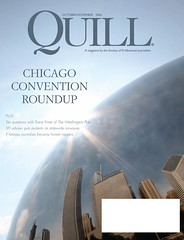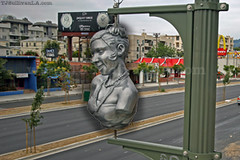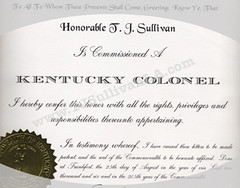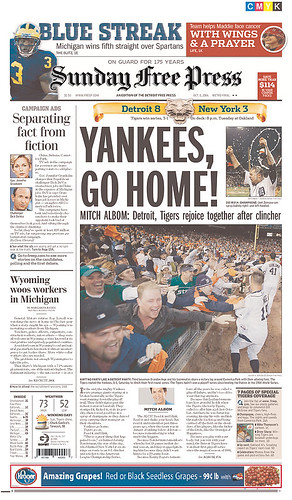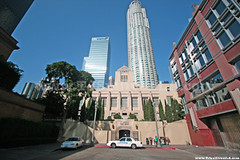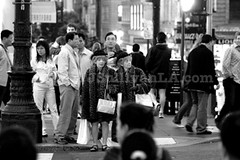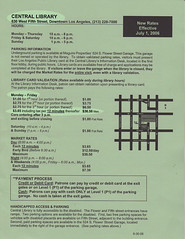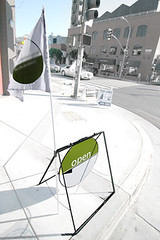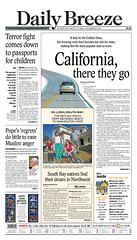My wife and I are hosting the family at our home on Christmas Day. It will be the first year we’ve done this. And, as you might expect, the stress level increases as the time draws near, and not just because it’s sure to be remembered as the Christmas we spent on the floor.
The adventure began Thanksgiving Day, when we decided that playing host meant it was time to spruce up our home. That led to the conclusion that we had to part with the couches each of us had brought to the marriage. Although I had resisted this final step into adulthood, I went willingly to our Westside Macy’s furniture store and stepped into the red-tag obstacle course. A sale was on, and it promised free delivery before Christmas...
Read the rest of this post at Native Intelligence.
— TJ Sullivan in LA
Independent reporting and commentary from TJ Sullivan, a national award-winning writer, formerly of Los Angeles, now living in Chicago. Sullivan is an author, independent journalist, photographer and college-level journalism instructor who has been featured as a speaker at several national writing conferences. To request an interview, or to inquire about scheduling Sullivan to speak at your event, please include the name and address of your organization and a contact telephone number.
Sunday, December 24, 2006
Median Home Price Drops 14.5% on Westside
Home prices are still on the rise in the Los Angeles region, but they're dropping on the Westside.
A news release this week from the California Association of Realtors links to DataQuick numbers that show a 14.5% drop in the median price of a home on the Westside when comparing Nov. '05 to Nov. '06.
In actual dollars the median price on the Westside went from $995,000 last November, to $851,000 this November, according to the DataQuick numbers quoted by CAR.
As always, however, it would be irresponsible to draw conclusions from those numbers alone. Unfortunately sales figures aren't provided for the Westside, which makes it impossible to conduct a proper analysis. In addition, CAR cautions that dramatic shifts can sometimes be attributed to "compositional changes in housing demand." In other words, it may just be that fewer high-end homes sold in November.
Santa Barbara is another standout with double-digit declines in its median price. Although the same quantity of homes sold there in Nov. '06 as did in Nov. '05, the median price reported by CAR indicates a drop of 23.4%, from $650,000 to $497,780.
Overall, CAR reported this week that the median price for a single family home in the Los Angeles region was $590,790 in November, a 2.7% increase over November 2005. Despite the uptick, the number of homes selling in the region dropped a whopping 21.6 percent .
CAR Vice President and Chief Economist Leslie Appleton-Young says the state is on track to notch a 7 percent price increase for the year, but she acknowledges that many areas of the state have seen declines.
More numbers are available here and here.
Also see earlier post: LA's Housing Crisis: 1.8% Affordability
— TJ Sullivan in LA
A news release this week from the California Association of Realtors links to DataQuick numbers that show a 14.5% drop in the median price of a home on the Westside when comparing Nov. '05 to Nov. '06.
In actual dollars the median price on the Westside went from $995,000 last November, to $851,000 this November, according to the DataQuick numbers quoted by CAR.
As always, however, it would be irresponsible to draw conclusions from those numbers alone. Unfortunately sales figures aren't provided for the Westside, which makes it impossible to conduct a proper analysis. In addition, CAR cautions that dramatic shifts can sometimes be attributed to "compositional changes in housing demand." In other words, it may just be that fewer high-end homes sold in November.
Santa Barbara is another standout with double-digit declines in its median price. Although the same quantity of homes sold there in Nov. '06 as did in Nov. '05, the median price reported by CAR indicates a drop of 23.4%, from $650,000 to $497,780.
Overall, CAR reported this week that the median price for a single family home in the Los Angeles region was $590,790 in November, a 2.7% increase over November 2005. Despite the uptick, the number of homes selling in the region dropped a whopping 21.6 percent .
CAR Vice President and Chief Economist Leslie Appleton-Young says the state is on track to notch a 7 percent price increase for the year, but she acknowledges that many areas of the state have seen declines.
More numbers are available here and here.
Also see earlier post: LA's Housing Crisis: 1.8% Affordability
— TJ Sullivan in LA
Tuesday, December 19, 2006
Back from New York City
I just returned from New York City where my days were much busier than anticipated. As a result, there was virtual silence at this blog for too many days in a row.
No longer...
More to come about how Gen-X artists in New York are becoming proactive in their approach to a housing market that's climbed far beyond their reach, as well as some year-end tidbits on Los Angeles real estate. And, of course, I'll post links here to everything I write over at Native Intelligence on LA Observed.
But first, there are some students waiting on a final examination that I must administer, so until then...
— TJ Sullivan in LA
Sunday, December 03, 2006
This UCLA Story Ends Without A Headline
UCLA's football team notched its first victory in seven years over cross-town rival USC and yet the Los Angeles Times somehow figured out a way to turn it into an A-1 story about USC.
See my latest blog entry at Native Intelligence.
— TJ Sullivan in LA
See my latest blog entry at Native Intelligence.
— TJ Sullivan in LA
Friday, November 24, 2006
Journalism Loses A Great Journalist
Former managing editor of The New York Times, Gerald Boyd, has died. He was 56.
Though few newspaper readers may know the name of their publication's managing editor, most NYT readers will sadly recall Boyd for being tangled in the scandal surrounding disgraced reporter Jayson Blair, who was exposed as a fabricator. Although that unfortunate circumstance has become "the comma" after Boyd's name, it is not a fair representation of his career.
A nice summary paragraph appeared in an Associated Press story. (Excerpt via Huffington Post):
Though few newspaper readers may know the name of their publication's managing editor, most NYT readers will sadly recall Boyd for being tangled in the scandal surrounding disgraced reporter Jayson Blair, who was exposed as a fabricator. Although that unfortunate circumstance has become "the comma" after Boyd's name, it is not a fair representation of his career.
A nice summary paragraph appeared in an Associated Press story. (Excerpt via Huffington Post):
The initial New York Times article stated that Boyd was "the first African-American to serve in many of the jobs he held at The Times, including metropolitan editor and managing editor," as well as winning a Nieman fellowship at age 28. Boyd joined the Times in 1983 and oversaw the 2000 Pulitzer Prize-winning series, "How Race is Lived in America." He took office on September 5, 2001 with former executive editor Howell Raines and together they led the paper through the terrorist attacks of September 11th, winning a Pulitzer Prize for its coverage.A quote from The New York Times executive editor Bill Keller appeared in an updated obituary by The Associated Press:
''He knew how to mobilize a reporting team and surround a story so that nothing important was missed. He knew how to motivate and inspire,'' executive editor Bill Keller said, according to The Times. ''And, tough and demanding as he could be, he had a huge heart. He left the paper under sad circumstances, but despite all of that he left behind a great reservoir of respect and affection.''One of the stories in The New York Times quotes a lecture Boyd gave a few years ago in St. Louis:
“Throughout my life I have enjoyed both the blessing and the burden of being the first black this and the first black that, and like many minorities and women who succeed, I’ve often felt alone.”— TJ Sullivan in LA
Tuesday, November 21, 2006
Tripping Back To Old Bakersfield
Hat tip to my friend at Amy's New York Notebook for pointing out the interactive map of Old Bakersfield created by The Bakersfield Californian. Although some may argue that Bakersfield is hardly a part of Los Angeles, the histories of both places are linked just as surely as are their futures, and so I don't think it's too much of a stretch to make note of it here.
Like a lot of Los Angelenoes, I can't say I know much about Bakersfield. My intial, knee-jerk reaction, I must admit, was to write it off as another dusty town that became the butt of bad jokes. But, thanks to some good friends who've lived and worked there in the past, as well as a few news assignments that forced me to spend several nights there, my familiarity with Bakersfield has improved. And, I have to say, the more I learn about the place, the more I find something to like.
Thanks to this map, I've learned a great deal more. How else would I have become aware, for instance, that in the 1950s a bar in the Padre Hotel featured a girl on a swing and a girl in a tub on stage?
It's worth the time to check out the map, if only to get some ideas.
— TJ Sullivan in LA
Like a lot of Los Angelenoes, I can't say I know much about Bakersfield. My intial, knee-jerk reaction, I must admit, was to write it off as another dusty town that became the butt of bad jokes. But, thanks to some good friends who've lived and worked there in the past, as well as a few news assignments that forced me to spend several nights there, my familiarity with Bakersfield has improved. And, I have to say, the more I learn about the place, the more I find something to like.
Thanks to this map, I've learned a great deal more. How else would I have become aware, for instance, that in the 1950s a bar in the Padre Hotel featured a girl on a swing and a girl in a tub on stage?
It's worth the time to check out the map, if only to get some ideas.
— TJ Sullivan in LA
Monday, November 20, 2006
LA's Housing Crisis: 1.8% Affordability
Call it a housing bubble. Call it a balloon. Call it nothing of the sort. But whatever you do, the California Building Industry Association wants you to realize that a housing crisis has gripped The Golden State, particularly the Greater Los Angeles Area.
How bad is it?
According to the numbers released today by CBIA, only 1.8 percent of the homes in the Los Angeles-Long Beach-Glendale region are affordable for households making the median income of $56,200 a year.
In contrast, 10 percent of homes in Ventura County are affordable to median-income earners.
But far more startling than that is the national average of 40.4 percent!
That makes the Los Angeles housing market the least affordable in the entire U.S.A.
Robert Rivinius, CBIA President and CEO, said this today in today's news release:
This is the eighth consecutive quarter that LA County has achieved the lowest affordability rank in the nation.
Even Orange County is better at 3.8 percent affordability for median income earners.
It's easy to beat this topic like a drum considering all the statistics available.
Some of the statistics, however, are changing.
The California Association of Realtors recently came up with some new math to calculate its affordability index. After 22 years CAR decided the old formula no longer offered a fair representation of the market.
CAR, whose national affiliate recently purchased advertisements boasting of a healthy housing market, has yet to release its affordability numbers for the third quarter of '06, but they should be coming soon, so keep watching CAR's list of news releases, or check back here.
— TJ Sullivan in LA
How bad is it?
According to the numbers released today by CBIA, only 1.8 percent of the homes in the Los Angeles-Long Beach-Glendale region are affordable for households making the median income of $56,200 a year.
In contrast, 10 percent of homes in Ventura County are affordable to median-income earners.
But far more startling than that is the national average of 40.4 percent!
That makes the Los Angeles housing market the least affordable in the entire U.S.A.
Robert Rivinius, CBIA President and CEO, said this today in today's news release:
“Despite all of the doom and gloom about housing prices dropping, affordability has improved only slightly and only in some parts of the state, and this does nothing to negate the fact that in the entire nation, the nine least affordable places to buy a home are here in California, as are 18 of the bottom 20.” Rivinius said. “When will our legislators and our local policy makers finally realize just how serious our housing affordability crisis is, and start taking steps to restore the American dream to more California families?”The state isn't in much better shape than Los Angeles. CBIA says homeownership is 57 percent, which is 13 points less than the national average.
This is the eighth consecutive quarter that LA County has achieved the lowest affordability rank in the nation.
Even Orange County is better at 3.8 percent affordability for median income earners.
It's easy to beat this topic like a drum considering all the statistics available.
Some of the statistics, however, are changing.
The California Association of Realtors recently came up with some new math to calculate its affordability index. After 22 years CAR decided the old formula no longer offered a fair representation of the market.
CAR, whose national affiliate recently purchased advertisements boasting of a healthy housing market, has yet to release its affordability numbers for the third quarter of '06, but they should be coming soon, so keep watching CAR's list of news releases, or check back here.
— TJ Sullivan in LA
Training tomorrow's reporters... in LA
My latest blog entry at Native Intelligence concerns my experiences in trying to connect the students in my journalism class with the Los Angeles Police Department.
Native Intelligence is a feature of LA Observed
— TJ Sullivan in LA
Native Intelligence is a feature of LA Observed
— TJ Sullivan in LA
Saturday, November 18, 2006
As Your Attorney I Advise You To Buy This Book...
A new book (with words even) by illustrator Ralph Steadman is reviewed in The New York TImes:
— TJ Sullivan in LA
The illustrator Ralph Steadman is a brave man. Not only did he survive humiliation, gunplay and hallucinatory despair through decades of collaboration with the legendarily difficult journalist Hunter S. Thompson, he decided to include as the epigraph to his memoir of those adventures a remark of Thompson’s: “Don’t write, Ralph. You’ll bring shame on your family.”
To follow this with a 400-page ramble is the sort of dare the prank-loving Thompson, who committed suicide last year, might have appreciated. For the sake of the Steadman family’s honor, it should be said that “The Joke’s Over” features a lot of Steadman’s drawings, though reduced too much from their original size. True, these pictures don’t exactly constitute writing, but they are brilliant. Splattery explosions of ink, detonated in the presence of politicians and stolid middle-class citizens, they stand as the mangling visions of a 20th-century Hogarth. When they originally appeared (usually in Rolling Stone), lodged amid Thompson’s prose, the images served as the visual equivalent of the writer’s “gonzo” — a term Steadman defines as “controlled madness” — explorations of America.
— TJ Sullivan in LA
Friday, November 17, 2006
Game Over
This time the masses that encircled the big box at the corner of Pico and Sawtelle boulevards didn't come bearing flowers and Sharpies hoping to meet Paris Hilton, or Dave Navarro. This was a far more serious affair. This was about money, and lots of it.
A new blog entry at Native Intelligence
— TJ Sullivan in LA
A new blog entry at Native Intelligence
— TJ Sullivan in LA
Friday, November 10, 2006
Marina Del NIMBY?
The latest Los Angeles real estate story in the The New York Times is today's take on LA County's planned renewal of Marina Del Rey's Fisherman's Village:
— TJ Sullivan in LA
Los Angeles County officials say that the new development, which they engineered as part of a plan to invigorate the aging marina, will attract more residents and visitors and generate as much as $30 million a year in new revenue.
[CUT...]
Marina del Rey has built the largest recreational marina in the world, according to the Marina del Rey Convention and Visitors Bureau — though it will be eclipsed by one under construction in Dubai. Its more than 5,000 boat slips and 804 acres of land and waterways are owned by the county. Aside from a few hundred condominiums, most housing consists of rental apartments.
But with its low-lying 1960s-vintage buildings and faux-Cape Cod shopping plaza, the marina is also a major financial underachiever. County officials expect the $30 million or so a year its leases earn to double as the addition of about 3,000 high-end apartments, new Woodfin and Marriott hotels and businesses like the Cheesecake Factory enhances land values.
Only about 8,000 people live in Marina del Rey, which is an unincorporated area of Los Angeles County; about half its acreage is under water. The population would increase significantly as four- and five-story apartment buildings replace two- and three-story ones just off the water.
— TJ Sullivan in LA
Tuesday, November 07, 2006
Could This Be The Popping Of Arizona's Bubble?
A story in today's New York Times headlined "In Arizona, 'For Sale' Is a Sign of the Times," shines a bright light on a dim scene in that state's housing market (where many California residents invested). The story also does some of the simple math regarding the rise in housing prices compared to wages.
Today, the number of unsold homes in the area has soared to almost 46,000 from just a few thousand in early 2005. And builders are pulling back as fast as they can.— TJ Sullivan in LA
They have little choice. Sales cancellations among big builders, not just here but around the country, are running as high as 40 percent, double the rate a year ago.
[CUT...]
Economists note that the construction sector, itself dependent on the housing boom, accounted for about a quarter of all new jobs created in the last six years. Lower-paying retail jobs added about 15 percent.
Wages rose, too, but not nearly as fast as home prices. In Maricopa County, which includes Phoenix and Scottsdale, median home values — half the homes are worth more, half are worth less — increased 64 percent, to $212,700, from 2001 to 2005, while the typical household’s income rose just 5 percent, to $48,711, according to the Census Bureau.
New homes cost more: the median price was $270,000 at the end of August, up from $250,000 a year ago, according to Hanley Wood, a research firm.
Sunday, November 05, 2006
Paris Was Only The Beginning...
Once again the Best Buy at Sawtelle and Pico boulevards is set to defy its industrial-sized lack of coolness by hosting a late-night celebrity event.
Read the post at Native Intelligence.
TJ Sullivan in LA
Read the post at Native Intelligence.
TJ Sullivan in LA
NAR Decries ‘Negative Media Coverage’
The National Association of Realtors says consumers are being misled by "negative media coverage on the current housing market."
To counter it, NAR has purchased full-page advertisements in six major newspapers this weekend (See the Real Estate section, page K-5, of today's Los Angeles Times). The ad is also set to run next weekend.
Included in the advertisement is a list of reasons why now is a "great time" to buy a home. Among the reasons is a buy-em-while-they-last sales pitch: "Large Inventory Won't Last."
Here's an exceprt from a news release regarding the ad:
— TJ Sullivan in LA
To counter it, NAR has purchased full-page advertisements in six major newspapers this weekend (See the Real Estate section, page K-5, of today's Los Angeles Times). The ad is also set to run next weekend.
Included in the advertisement is a list of reasons why now is a "great time" to buy a home. Among the reasons is a buy-em-while-they-last sales pitch: "Large Inventory Won't Last."
Here's an exceprt from a news release regarding the ad:
The ad encourages consumers to ignore the negative media coverage on the current housing market and reminds them that the time is right to buy now, for several reasons:
* Interest rates are low
* A good inventory of homes is available
* Prices have stabilized and are starting to rise
* The future of the housing market and the economy is positive
* Housing is a great investment, with average home valuations increasing 88 percent in the last 10 years
— TJ Sullivan in LA
The Herd Mentality
The impact of peer pressure on the housing market is explored today in the Real Estate section of the Los Angeles Times:
The urge to follow the herd leads to spending beyond one's means or failing to set realistic sales prices, behavioral economists say. Or forgetting that bison sometimes stampede off cliffs, buyers see "everyone" buying homes and gaining equity, and they want in too. There's always safety in numbers, consumers assure themselves, and if they make a mistake, the misery can be shared.— TJ Sullivan in LA
During the bull market, buyers feared being priced out of the market. This thinking may account for the fact that higher-risk negative-amortization loans made up 17.4% of all loans in California through July of this year , up from 14.8% in 2005, according to First American LoanPerformance, a data-tracking firm.
Once in, overextended buyers often become victims of "bubble thinking," said Richard L. Peterson, a psychiatrist and managing partner of San Francisco-based Market Psychology Consulting. Buyers gamble that the value of their homes will increase, even if they're losing money every month due to negative amortization loans and lack of equity actually accruing.
Saturday, November 04, 2006
The Sword Dangling Over Gen Xers
70% More Debt Than Carried By Their Parents
Eventually, someone's going to have to start talking about how Generation X is supposed to pay for the homes it purchased in the past few years, let alone how it's supposed to pay for retirement. Regardless of whether you're a bubble believer, or not, few can argue about the poor prognosis for Social Security, or how lax Americans have been (and continue to be) about saving money.
If the leveling off of housing prices remains relatively level, as some of the most optimistic analysts expect it to do for several years, isn't there still a significant possibility of financial disaster ahead for Gen X?
Consider the comments about Generation X that appeared in a recent story by MarketWatch:
The issue was hinted at in the MarketWatch piece, but primarily in reference to flippers. The following excerpt quotes Ron Terwilliger, CEO of home builder Trammell Crow Residential:
Eventually, someone's going to have to start talking about how Generation X is supposed to pay for the homes it purchased in the past few years, let alone how it's supposed to pay for retirement. Regardless of whether you're a bubble believer, or not, few can argue about the poor prognosis for Social Security, or how lax Americans have been (and continue to be) about saving money.
If the leveling off of housing prices remains relatively level, as some of the most optimistic analysts expect it to do for several years, isn't there still a significant possibility of financial disaster ahead for Gen X?
Consider the comments about Generation X that appeared in a recent story by MarketWatch:
Generation X, typically defined as those born between 1965 and 1979, comprise a little more than half of the market for newly constructed homes, said James Chung, president of Reach Advisors, a Boston-based marketing strategy and research firm.Although the story focuses on the issue from a marketing perspective, reading it made me wonder what options will be available to the young homebuyers who took on monster housing debt only because they believed they'd be able to use fast equity as an escape hatch from the impossible terms of exotic mortgage products. When that equity doesn't materialize and the loan terms slam down like a hammer, there's a good chance the pain will be felt by far more than just those who took the risk.
But that doesn't mean the homes that lured baby boomers, born between 1946 and 1964, are meeting the needs of the 30-somethings shopping now.
"It's the trade-off generation. It's no longer sort of the live-large mindset," Chung said. "They're living under different economic realities than their predecessors. They carry 70% more debt than the baby boomers did at that point in their lives because of the cost of housing.... Almost all of that is housing debt."
The issue was hinted at in the MarketWatch piece, but primarily in reference to flippers. The following excerpt quotes Ron Terwilliger, CEO of home builder Trammell Crow Residential:
"The reason this cycle went up so high and flattened so quickly is more speculative buying than I've seen in my 35 years in the business," Terwilliger said. "It's unfortunate so many people bought intending to flip."-- TJ Sullivan in LA
It will take time to regain equilibrium, he said. "There's a lot of pain going on in the investment community."
Friday, November 03, 2006
Nine Minutes
The devil is in the details. It's an axiom that's called to mind by many Los Angelenos as they endeavor to interpret parking signs after receiving a ticket.
Fume as we may about parking officers who swoop and cite our vehicles within the minute the meter expires, most of us have always understood the bit about the details.
As burned as we may feel by the sting of a citation, few would suggest that they were duped by some sort of intentional visual trickery. The mere notion that a parking department would engage in skulduggery seems lunatic. Read the sign. Follow the rules. It's simple.
That's why I'm sure there's a good explanation for why a string of "9 hour parking" meters in the 1100 block of Colorado Ave in Santa Monica is blended with a couple "9 minute parking" meters (see photo inset). Surely "9 minute parking" meters exist other places, not just next to "9 hour parking" meters. Don't they?
The 9-minute duration is odd. Why not 10, or 15 minutes? How about 8 minutes? And, while we're at it, why does the "9 minute parking" meter allow the purchase of far more time than permitted by the nine-minute limit?
In the spirit of search-engine dominated Santa Monica (both Yahoo and Google have offices there), I tried to find some answers online.
I conducted a simple Google search of "15 minute parking" and it yielded more than 28,000 hits. There were 7,900 at Yahoo. The phrase "10 minute parking" returned about 850 on Google and nearly 13,000 on Yahoo. But, "9 minute parking" failed to return a single document from either Google, or Yahoo. Nothing.
Of course, such statistics are meaningless because the sign still says what it says. But I just can't figure any other way to make the point without sounding like, well, a yahoo.
Cross posted at LA Observed.
— TJ Sullivan in LA
Fume as we may about parking officers who swoop and cite our vehicles within the minute the meter expires, most of us have always understood the bit about the details.
As burned as we may feel by the sting of a citation, few would suggest that they were duped by some sort of intentional visual trickery. The mere notion that a parking department would engage in skulduggery seems lunatic. Read the sign. Follow the rules. It's simple.
That's why I'm sure there's a good explanation for why a string of "9 hour parking" meters in the 1100 block of Colorado Ave in Santa Monica is blended with a couple "9 minute parking" meters (see photo inset). Surely "9 minute parking" meters exist other places, not just next to "9 hour parking" meters. Don't they?
The 9-minute duration is odd. Why not 10, or 15 minutes? How about 8 minutes? And, while we're at it, why does the "9 minute parking" meter allow the purchase of far more time than permitted by the nine-minute limit?
In the spirit of search-engine dominated Santa Monica (both Yahoo and Google have offices there), I tried to find some answers online.
I conducted a simple Google search of "15 minute parking" and it yielded more than 28,000 hits. There were 7,900 at Yahoo. The phrase "10 minute parking" returned about 850 on Google and nearly 13,000 on Yahoo. But, "9 minute parking" failed to return a single document from either Google, or Yahoo. Nothing.
Of course, such statistics are meaningless because the sign still says what it says. But I just can't figure any other way to make the point without sounding like, well, a yahoo.
Cross posted at LA Observed.
— TJ Sullivan in LA
Monday, October 30, 2006
Katie Couric's In Town
CBS Evening News host Katie Couric is in town today, as noted in her daily e-mail to viewers:
— TJ Sullivan in LA
While we’re in California, we’re looking at this trend-setting state’s politics. Amid gridlock in Washington, California is leading a host of others states in tackling groundbreaking issues the federal government won’t touch. Sandra Hughes will bring us that report.The event, Reagan Retrospective with Governor Arnold Schwarzenegger, at the Ronald Reagan Presidential Library in Simi Valley is sold out.
[CUT…]
Finally, while we were in California today, Ronald Reagan’s widow Nancy and political luminaries gathered today to celebrate the late president’s life. It was 40 years ago when Reagan was elected governor of California. Jerry Bowen will look back at how the Reagan revolution started and its legacy for Republicans today.
— TJ Sullivan in LA
775,766
Los Angeles Times circulation has dropped to 775,766, according to new numbers from the Audit Bureau of Circulations FAS-FAX.
LAT Publisher David Hiller spins it with some positive insight, as reported at LA Observed:
It's about counting not just copies sold, but eyes as well.
As explained by the Audit Bureau, the readers-per-copy average is complicated enough to warrant a white paper on the subject. Anything that's not verifiable by a receipt is bound to cause controversy, especially when advertisers are asked to pay more for an ad because of it.
In the simplest terms, however, reader counts are all about counting not just the people who buy a copy of the paper, but those who read behind the person who bought it. Two people in a subscriber household? Bing! That's two readers for that subscription. Husband and wife buy a paper on their way to breakfast with another couple? Bong! That's four sets of eyes.
So, what Hiller appears to be saying is that fewer people are paying to read the LA Times, but more people are reading it.
— TJ Sullivan in LA
LAT Publisher David Hiller spins it with some positive insight, as reported at LA Observed:
Importantly, readership increased modestly for both daily and Sunday, reaching almost 2.2 million daily and 3.3 million Sunday.How can this be, you ask?
It's about counting not just copies sold, but eyes as well.
As explained by the Audit Bureau, the readers-per-copy average is complicated enough to warrant a white paper on the subject. Anything that's not verifiable by a receipt is bound to cause controversy, especially when advertisers are asked to pay more for an ad because of it.
In the simplest terms, however, reader counts are all about counting not just the people who buy a copy of the paper, but those who read behind the person who bought it. Two people in a subscriber household? Bing! That's two readers for that subscription. Husband and wife buy a paper on their way to breakfast with another couple? Bong! That's four sets of eyes.
So, what Hiller appears to be saying is that fewer people are paying to read the LA Times, but more people are reading it.
— TJ Sullivan in LA
Sunday, October 29, 2006
Here Lies Felix Unger...
I've got a couple new posts at LA Observed, including one about the modest cemetery in Westwood, at which the actors who portrayed Oscar Madison and Felix Unger in the movie "The Odd Couple" are interred. See Native Intelligence for more.
— TJ Sullivan in LA
— TJ Sullivan in LA
Friday, October 27, 2006
Better Luck Next Year
Residents of Pinconning, Mich., can start using the old stationary again, at least until next October.
The city's name change to Tigertown was only in effect as long as the Tigers were in the World Series.
— TJ Sullivan in LA
The city's name change to Tigertown was only in effect as long as the Tigers were in the World Series.
— TJ Sullivan in LA
Wednesday, October 25, 2006
LA Home Sales Plunge 31 Percent, Median Up 2
The California Association of Realtors reported today that home sales decreased 31.7 percent statewide last month when compared to September 2005. The Los Angeles region was right in line with the state trend, experiencing a 31.2 percent drop. Orange County was down 32 percent, and Ventura County sunk nearly 39 percent.
Despite all this, the median home price still increased 1.8 percent statewide.
In LA, the median went from $560,990 in Sept. 2005 to $585,730 last month (down from the August '06 median price of $589,740).
Ventura County, which saw the most significant drop off in sales in Southern California, actually bumped up its median price, from $682,360 in Sept. '05 to $686,730 last month.
The median price in the OC dropped to $706,490 from $708,840 last year.
— TJ Sullivan in LA
Despite all this, the median home price still increased 1.8 percent statewide.
In LA, the median went from $560,990 in Sept. 2005 to $585,730 last month (down from the August '06 median price of $589,740).
Ventura County, which saw the most significant drop off in sales in Southern California, actually bumped up its median price, from $682,360 in Sept. '05 to $686,730 last month.
The median price in the OC dropped to $706,490 from $708,840 last year.
— TJ Sullivan in LA
Selling High-End Homes On YouTube?
Just imagine having drinks with Annette Bening, Warren Beatty and Jack Nicholson "because those would be your neighbors if you purchase this home." Seriously, that's part of the sales pitch in this video tour of a "Beverly Hills Mansion With Views of the Pacific," as posted on YouTube.
Not sure how effective it is marketing mansions on YouTube, but there's plenty of real estate professionals in Los Angeles using it as a resource.
— TJ Sullivan in LA
Tuesday, October 24, 2006
Now Blogging At LA Observed ...
I'm proud to say I have been asked by Kevin Roderick, founder and editor of LA Observed, to join his team of contributors at large.
As a result, I have begun posting in the Native Intelligence section of the LA Observed Web site, and will continue to do so at least on a weekly basis, but hopefully more often than that.
Little will change at TJ Sullivan in LA. My posts here will continue to focus on the pursuit of the American dream in Los Angeles. I plan to provide links on this blog to my writing at Native Intelligence, where the emphasis will be observations and news about Los Angeles, particularly the West Side.
I hope you'll find it worthwhile to visit both Web sites.
My first post at Native Intelligence is headlined Planet Starbucks knows no boundaries.
— TJ Sullivan in LA
As a result, I have begun posting in the Native Intelligence section of the LA Observed Web site, and will continue to do so at least on a weekly basis, but hopefully more often than that.
Little will change at TJ Sullivan in LA. My posts here will continue to focus on the pursuit of the American dream in Los Angeles. I plan to provide links on this blog to my writing at Native Intelligence, where the emphasis will be observations and news about Los Angeles, particularly the West Side.
I hope you'll find it worthwhile to visit both Web sites.
My first post at Native Intelligence is headlined Planet Starbucks knows no boundaries.
— TJ Sullivan in LA
Thursday, October 19, 2006
DOWNTOWN: Staph Spread By Shared Surfaces
Hat tip to LA Observed for pointing out an alarming story in LA Weekly about the spread of methicillin-resistant staph infections in downtown Los Angeles. According to the story:
— TJ Sullivan in LA
The bacterium that transmits staph can be passed through touch, shared surfaces and personal items like razors or towels. It can stay on clothes or bedding for five days. The infection often is dismissed as a large pimple, ingrown hair or a spider bite, but it comes on quickly and is extremely painful. In some cases, it looks more like a rash or cellulitis. Most cases are easily treatable with antibiotics; in rare instances, staph can cause blood, bone and lung infections.Many of the victims are homeless people who lack access to proper hygeine. The infection has also allegedly been spread to people who interact with the homeless population, including firefighters and police officers. Other victims may have had the infection spread to them by family members who work downtown.
— TJ Sullivan in LA
Wednesday, October 18, 2006
On The Cover Of A Magazine
The cover for the October/November 2006 edition of Quill features a photograph I took this summer in Chicago. Quill is the Society of Professional Journalists national magazine and is published 9 times a year by SPJ.
The photo is of the morning sun cresting Cloud Gate in Millennium Park in Chicago. Also referred to as "The Bean," Cloud Gate is a 110-ton elliptical sculpture made of highly polished stainless steel plates. I took the photograph during this year's SPJ convention, which was held in Chicago in August.
Quill is available for download in pdf format at the SPJ Web site.
— TJ Sullivan in LA
The photo is of the morning sun cresting Cloud Gate in Millennium Park in Chicago. Also referred to as "The Bean," Cloud Gate is a 110-ton elliptical sculpture made of highly polished stainless steel plates. I took the photograph during this year's SPJ convention, which was held in Chicago in August.
Quill is available for download in pdf format at the SPJ Web site.
— TJ Sullivan in LA
Sunday, October 15, 2006
Busted Deadline, Busted Budget, And A Bust
Many commuters in West LA are more than ready to heave a sigh of relief as the last of the orange cones begin to disappear from the $90-million Santa Monica Boulevard Transit Parkway Project.
Not only did this project bust its budget by more than $20 million, it also busted deadline by a year.
And now, there's a bust to watch over it.
This afternoon I spotted the curious bust pictured at right, along with some other works of art on the new lampposts along Santa Monica Boulevard west of Beverly Glen Boulevard.
A Sept. 27, 2006, press release from the LA City Department of Public Works implies that she and other works are part of the art that will cap off the project. According to the release:
— TJ Sullivan in LA
Not only did this project bust its budget by more than $20 million, it also busted deadline by a year.
And now, there's a bust to watch over it.
This afternoon I spotted the curious bust pictured at right, along with some other works of art on the new lampposts along Santa Monica Boulevard west of Beverly Glen Boulevard.
A Sept. 27, 2006, press release from the LA City Department of Public Works implies that she and other works are part of the art that will cap off the project. According to the release:
As roadway construction nears completion of the Santa Monica Boulevard Transit Parkway Project, crews are preparing to install project art work. Artistic medallions designed to showcase state themes along historic Route 66 will hang from steetlighting fixtures on Santa Monica Blvd. A pair of ruby red shoes will symbolize Kansas, while a likeness of Abraham Lincoln will represent Illinois.I don't know who she's supposed to represent, though I'm sure I'll regret writing that when someone informs me of the person in whose likeness this was cast. In the meantime, if I may be so bold as to embellish a line from the 1996 film Swingers: She's so money, and she doesn't even know it.
— TJ Sullivan in LA
Friday, October 13, 2006
Caltrans Cam Links Online
Did you know that Caltrans has links to many of its traffic cameras online? The choices in Los Angeles are few, considering how many exist, but there are many for the rural areas of the state.
I couldn't get any of the LA cameras to work, but the one up in Sacremento (pictured at right) was very clear.
The site also has a Photolog, which can serve as an online road atlas for the entire state. In addition, there's a Statewide Travel Information feature.
— TJ Sullivan in LA
I couldn't get any of the LA cameras to work, but the one up in Sacremento (pictured at right) was very clear.
The site also has a Photolog, which can serve as an online road atlas for the entire state. In addition, there's a Statewide Travel Information feature.
— TJ Sullivan in LA
Tuesday, October 10, 2006
That's 'Colonel' T.J. Sullivan, If You Don't Mind
It's official.
I have been commissioned by the governor of the Commonwealth of Kentucky as a Kentucky Colonel, joining a list of colonels far more distinguished than me.
I have called five states home in my life, but never was made to feel more at home than I was when I lived in Kentucky.
— TJ Sullivan in LA
I have been commissioned by the governor of the Commonwealth of Kentucky as a Kentucky Colonel, joining a list of colonels far more distinguished than me.
I have called five states home in my life, but never was made to feel more at home than I was when I lived in Kentucky.
— TJ Sullivan in LA
Monday, October 09, 2006
Another Reason To Worry About Housing
Robert J. Samuelson's column in the Oct. 16 edition of Newsweek points out some important facts about the national housing market.
Of particular concern are the figures he quotes on overvalued markets. The numbers, which came from a survey by Global Insight and National City Corp., said that by the middle of this year 236 metro areas had overvalued housing markets. As if that number weren't a concern in and of itself, it's particularly worrysome when put in the context of survey results from early 2000, when only 63 metro areas were judged as being overvalued.
From Samuelson's column:
— TJ Sullivan in LA
Of particular concern are the figures he quotes on overvalued markets. The numbers, which came from a survey by Global Insight and National City Corp., said that by the middle of this year 236 metro areas had overvalued housing markets. As if that number weren't a concern in and of itself, it's particularly worrysome when put in the context of survey results from early 2000, when only 63 metro areas were judged as being overvalued.
From Samuelson's column:
We are at the endgame for housing. Until recently, our national motto has been "in real estate we trust." Just last week, the Census Bureau reported that median home prices after inflation rose 32 percent from 2000 to 2005. In some places, the gains were huge: 127 percent in San Diego, 110 percent in Los Angeles and 79 percent in New York. But real estate—which has acted as a national piggy bank, with homeowners borrowing and spending against rising house prices—no longer looks so trustworthy. On this, more than falling oil prices or a record Dow, hangs the economy's immediate fate.
— TJ Sullivan in LA
Sunday, October 08, 2006
Trying To Curb My Enthusiasm For Detroit
You'll have to forgive the tangential celebration of Detroit's victory over the Yankees, particularly in light of the Dodger's unfortunate departure from post-season play last night.
I've been a Tiger fan most of my life and, although we've endured nowhere near the suffering of our friends at Wrigley Field, or out in Boston, Tiger fans have suffered more than the average amount of ridicule and disappointment. For the past 12 years, the Tigers were baseball's most losingest team. That's 1,170 losses. With 162 games in the regular season, that means if you attended a Tiger game anytime since 1994, there's a 60 percent chance that you saw them lose. I did, at least a couple times.
Granted, Tiger fans have not earned the right to complain. They do not deserve pity. Even when their team wins, some of the fans behave like depraved losers. Rather than bask in the glory that was 1984, Tiger fans started a near-riot, turning over police vehicles and setting them on fire.
That aside, the team in 1984 was one of baseball's greatest, a collection of players who went on to prove their worth elsewhere. Some ended up in LA (Kirk Gibson!) and the manager even retired here (Sparky Anderson lives in the upscale LA suburb of Thousand Oaks).
I'll try to contain my enthusiasm and stay on point during these next few weeks, but it may be difficult, particularly when I read the poetry that is Mitch Albom's column. Next stop, Oakland.
— TJ Sullivan in LA
I've been a Tiger fan most of my life and, although we've endured nowhere near the suffering of our friends at Wrigley Field, or out in Boston, Tiger fans have suffered more than the average amount of ridicule and disappointment. For the past 12 years, the Tigers were baseball's most losingest team. That's 1,170 losses. With 162 games in the regular season, that means if you attended a Tiger game anytime since 1994, there's a 60 percent chance that you saw them lose. I did, at least a couple times.
Granted, Tiger fans have not earned the right to complain. They do not deserve pity. Even when their team wins, some of the fans behave like depraved losers. Rather than bask in the glory that was 1984, Tiger fans started a near-riot, turning over police vehicles and setting them on fire.
That aside, the team in 1984 was one of baseball's greatest, a collection of players who went on to prove their worth elsewhere. Some ended up in LA (Kirk Gibson!) and the manager even retired here (Sparky Anderson lives in the upscale LA suburb of Thousand Oaks).
I'll try to contain my enthusiasm and stay on point during these next few weeks, but it may be difficult, particularly when I read the poetry that is Mitch Albom's column. Next stop, Oakland.
— TJ Sullivan in LA
Saturday, October 07, 2006
DETROIT REJOICES!
Tigers win first playoff series in 22 years
By MITCH ALBOM
October 7, 2006
In the end, the Yankees were a bunch of grumpy giants staring at a broken beanstalk. And the Tigers? They didn't tiptoe past the richest team in baseball. They stomped it, kicked it and stole its jewelry, then waved a happy good-bye and headed on down the playoff road.
Yankees go home.
Tigers go on.
Read it and blink. Read it and shake your head. Read it and ask, "Who are these guys in the Detroit uniforms?" Read it and remember just three seasons ago, when this team was in danger of sinking below oblivion.
Read it and remember, because remembering is what made this happen.
Telephone Operator, You're My Aural Violator*
* With appologies to Pete Shelley
I continue to be puzzled by people who carry on cell phone conversations without hesitation while huddled in the stacks of the Los Angeles Public Library downtown.
Again today I witnessed a number of uninhibited analogue dialogues in the literature section, all of which were carried out at full cell-yell volume.
Although not addressed explicitly in the Library Rules of Conduct, it would seem to be banned implicitly.
The library staff shouldn't have to act as peace officers, so maybe that's why the Library doesn't spell it out. Besides, where do you stop drawing the line when people persist in exhibiting bad behavior? How many principles of common sense need to be spelled out on a list no one looks at anyway? Already the library has explicitly banned "sexual misconduct," "insulting language," and "bathing."
Yes, there's an explicit ban on bathing, although it's unclear whether that includes the shaving of chin whiskers, or the brushing of teeth.
As I've said before, I have great affection for the Central Library. In the past few weeks I've made frequent use of it. As a result, I have witnessed how the Library deals effectively with a variety of potential problems. I've seen the uniformed officers patrol every level, going so far as to physically nudge homeless people who seek out the most comfortable chairs and proceed to nap (sleeping is prohibited in the Rules of Conduct).
Were the decision mine, I might rearrange the priorities, or at least bump one rule up to priority status. As inconvenient as the presence of a snoring sleeper might be to some library patrons, I find it far less disruptive than the cell phone conversations of the gainfully employed.
At least those who snore can argue that they're not snoring on purpose.
— TJ Sullivan in LA
I continue to be puzzled by people who carry on cell phone conversations without hesitation while huddled in the stacks of the Los Angeles Public Library downtown.
Again today I witnessed a number of uninhibited analogue dialogues in the literature section, all of which were carried out at full cell-yell volume.
"Yeah, ok, what? ... No, what kind? ... When? ... Oh, yeah. ... Wait, while I've got you on the phone I wanted to ...Coffee shops and cafes have grown tired of this, some to the point of agressively forbiding cell phone use. And yet, in a public library where patrons have a time-honored expectation of peace and quiet, the behavior continues unabated.
Although not addressed explicitly in the Library Rules of Conduct, it would seem to be banned implicitly.
THE FOLLOWING ARE PROHIBITED...Perhaps what's confusing is the text beneath the 11 prohibitions, where the Library says:
"Disruptive or unsafe behavior including any conduct that interferes with the use of the library by others or with the functioning of library staff."
"To avoid disturbing other library users, mute the volume of electronic devices and use cell phones in the lobby or outside the library."Is it a ban? Is it a suggestion?
The library staff shouldn't have to act as peace officers, so maybe that's why the Library doesn't spell it out. Besides, where do you stop drawing the line when people persist in exhibiting bad behavior? How many principles of common sense need to be spelled out on a list no one looks at anyway? Already the library has explicitly banned "sexual misconduct," "insulting language," and "bathing."
Yes, there's an explicit ban on bathing, although it's unclear whether that includes the shaving of chin whiskers, or the brushing of teeth.
As I've said before, I have great affection for the Central Library. In the past few weeks I've made frequent use of it. As a result, I have witnessed how the Library deals effectively with a variety of potential problems. I've seen the uniformed officers patrol every level, going so far as to physically nudge homeless people who seek out the most comfortable chairs and proceed to nap (sleeping is prohibited in the Rules of Conduct).
Were the decision mine, I might rearrange the priorities, or at least bump one rule up to priority status. As inconvenient as the presence of a snoring sleeper might be to some library patrons, I find it far less disruptive than the cell phone conversations of the gainfully employed.
At least those who snore can argue that they're not snoring on purpose.
— TJ Sullivan in LA
Friday, October 06, 2006
Lawsuit Alleges Mortgage Fraud Fed By Froth
Few of those paying attention to the housing market during the past five years will be surprised by this one.
A story in The New York Times today details an alleged mortgage fraud case in Indiana. Industry experts and regulators say the housing boom of the past few years, and its associated avarice, proved fertile ground for swindlers. "Rising home prices served as cover for quick-flip plans and an easy hook to recruit investors," says The New York Times:
Email
A story in The New York Times today details an alleged mortgage fraud case in Indiana. Industry experts and regulators say the housing boom of the past few years, and its associated avarice, proved fertile ground for swindlers. "Rising home prices served as cover for quick-flip plans and an easy hook to recruit investors," says The New York Times:
And the boom created incentives for the mortgage industry not to look too closely. As the appetite for home loans soared on Main Street and Wall Street, the industry came to increasingly rely on networks of independent mortgage brokers, appraisers and other officials to keep the lending assembly line well supplied. All had incentives to minimize hold-ups.
“If the deal doesn’t go through, nobody gets paid,” said Bill Matthews, a senior vice president at the Conference of State Bank Supervisors.
Thursday, October 05, 2006
Pacific Coast Highway ...
I was on Pacific Coast Highway in Northern California a couple days ago.
It's always a longer drive than the 101, not to mention the 5. But, there's more to see on the PCH.
I've always believed in stopping the car if you're going to take the usual cow photo. I've included that one and a few others* from the trip.
(* The ducks are in Golden Gate Park in San Francisco, not on PCH.)
Email
It's always a longer drive than the 101, not to mention the 5. But, there's more to see on the PCH.
I've always believed in stopping the car if you're going to take the usual cow photo. I've included that one and a few others* from the trip.
(* The ducks are in Golden Gate Park in San Francisco, not on PCH.)
Wednesday, October 04, 2006
The San Francisco Twins
Just got back from a trip up to San Francisco for a few days... Still clearing the desktop, but wanted to post a photo from the journey.
It's of the famous and beloved San Francisco Twins.
They are Marian and Vivian Brown. They look alike. They dress alike. They wear Giorgio perfume. They are one, er, two reasons I have such affection for the city of San Francisco.
I love Los Angeles, without question, but somehow seeing The Twins in downtown San Francisco is a more wholesome, happy experience than seeing Angelyne in West Hollywood.
I was lucky enough to capture this shot Saturday, which was obviously leopard skin coat day. Of course, I had to run around the block to get into position and await their arrival at Union Square, but, fortunately, they were in no hurry.
Email
It's of the famous and beloved San Francisco Twins.
They are Marian and Vivian Brown. They look alike. They dress alike. They wear Giorgio perfume. They are one, er, two reasons I have such affection for the city of San Francisco.
I love Los Angeles, without question, but somehow seeing The Twins in downtown San Francisco is a more wholesome, happy experience than seeing Angelyne in West Hollywood.
I was lucky enough to capture this shot Saturday, which was obviously leopard skin coat day. Of course, I had to run around the block to get into position and await their arrival at Union Square, but, fortunately, they were in no hurry.
Wednesday, September 27, 2006
As If It Wasn't Already Confusing Enough...
Monday, September 25, 2006
LA's 10 Richest Residents
Forbes has released its list of The 400 Richest Americans. The top 10 in Los Angeles are:
Email
1. Kirk Kerkorian
Overall Rank: 26, $9.0 billion, 89 years old, investments, casinos
2. Eli Broad
Overall Rank: 42, $5.8 billion, 73 years old, investments
3. David Howard Murdock
Overall Rank: 59, $4.2 billion, 83 years old, investments
4. Patrick Soon-Shiong
Overall Rank: 77, $3.4 billion, 54 years old, generic drugs
5. Ronald Burkle
Overall Rank: 117, $2.5 billion, 53 years old, supermarkets, investments
6. Alfred Mann
Overall Rank: 140, $2.2 billion, 80 years old, inventor, entrepreneur
7. Michael Robert Milken
Overall Rank: 153, $2.1 billion, 60 years old, investments
8. David Whitmire Hearst Jr
Overall Rank: 160, $2.0 billion, 61 years old, Hearst Corp
9. George Randolph Hearst Jr
Overall Rank: 160, $2.0 billion, 79 years old, Hearst Corp
10. Anthony Pritzker
Overall Rank: 160, $2.0 billion, 45 years old, hotels, investments
National Median Price Falls For 1st Time in 11 yrs
The national median price on previously owned homes fell in August, the first time it's done so in 11 years.
From The New York Times:
Email
From The New York Times:
The National Association of Realtors reported today that existing home sales dropped 0.5 percent from July to August to a seasonally adjusted annual rate of 6.3 million units. That compares with a decline from June to July of 4.1 percent.From the Los Angeles Times:
On a regional basis, the West was the only part of the nation in August to report an increase in the median sales price, a meager 0.3% rise to $345,000. Sales, meanwhile, fell 2.3%.From the California Association of Realtors:
Home sales decreased 30.1 percent in August in California compared with the same period a year ago, while the median price of an existing home increased 1.6 percent, the CALIFORNIA ASSOCIATION OF REALTORS® (C.A.R.) reported today.
“We experienced the greatest year-to-year sales decline last month since August 1982, when sales fell 30.4 percent,” said C.A.R. President Vince Malta. “This is another indication that we’re in the initial stages of a long-anticipated adjustment in the market.
“Buyers today have a much greater selection of properties from which to choose, while some sellers are still clinging to price expectations that are no longer valid in today’s market,” he said.
Tuesday, September 19, 2006
My $36.50 Parking Education
I've been doing a lot of research this month at the Central Library downtown, and thought I'd figured out the parking situation.
And then came the $36.50 bill.
I'd spent more than four and a half hours in the stacks, and so, of course, I should have been punished. But $36.50?
This might be a hint as to why it seems few people use the library downtown.
— TJ Sullivan in LA
And then came the $36.50 bill.
I'd spent more than four and a half hours in the stacks, and so, of course, I should have been punished. But $36.50?
This might be a hint as to why it seems few people use the library downtown.
— TJ Sullivan in LA
Builder Confidence Lowest Since Feb. 1991
The latest National Association of Home Builders/Wells Fargo Housing Market Index says builder confidence is at its lowest level in 15 years.
NAHB Chief Economist David Seiders offered the following analysis in a press release:
Email
NAHB Chief Economist David Seiders offered the following analysis in a press release:
“Builders are adopting an increasingly cautious attitude in their near-term outlook for new-home sales,” said NAHB Chief Economist David Seiders. “They’re experiencing falling sales, rising sales cancellations, and increasing inventories of unsold units. And although many builders are offering substantial incentives to bolster sales and limit cancellations, many potential buyers now are waiting on the sidelines to see how the market shakes out before proceeding with a home purchase.The HMI follows an adjustment issued earlier this month by the National Association of Realtors, which said home sales will fall about 8 percent in 2006.
“We are in the midst of an anticipated adjustment period as the housing market subsides from the record-breaking and unsustainable highs of the past few years,” Seiders noted. “Our forecast projects the numbers flattening out around the middle of next year and gradually moving back up towards trend in 2008.
“That said, long-term housing fundamentals will be very favorable,” he added. “In fact, the housing market that emerges from this correction will have better balance between supply and demand and will be able to ride on excellent underlying fundamentals for years to come.”
Monday, September 18, 2006
Housing Starts Report Due Tuesday Morning
Housing starts likely fell in August, says Bloomberg.com:
Email
The Commerce Department is scheduled to release the housing starts report at 8:30 a.m. in Washington. The Labor Department will put out the producer prices report at the same time.* UPDATE: Housing starts drop, inflation tame, says Bloomberg.com
Estimates for housing starts ranged from 1.62 million to 1.85 million at an annual rate. Total PPI forecasts were from a drop of 0.1 percent to an increase of 0.9 percent.
Sunday, September 17, 2006
Signs On The Dotted Line
This week's addition to the Signs on the Dotted Line gallery.
Intersection suggestions welcome.
— TJ Sullivan in LA
Intersection suggestions welcome.
— TJ Sullivan in LA
Say Goodbye To California
Interesting numbers piece about outward migration on today's front page of the Daily Breeze. The subhead hints at the reason people want to leave: "Housing costs have become too rich for many…"
The nation's most populous state, a traditional magnet for throngs of daring, ambitious people seeking everything from gold nuggets and great weather to good jobs and Hollywood glamour, now carries an unflattering designation.Email
The Golden State is No. 1 in outward migration of residents to other states, according to the most recent figures provided by the U.S. Census Bureau.
From July 1, 2004, to July 1, 2005, the net flow of residents from California to other states -- those moving to the state minus those leaving -- was negative 239,000 people. That's higher than any other state in the union.
California even edged out former No. 1 New York by 7,000 people.
[CUT...]
As of last year, the state's outflow was at its highest point since the mid-1990s, when a severe recession and aerospace industry slump drove engineers and other professionals out of California in search of work.
Thursday, September 14, 2006
Random Photo
I was downtown this weekend to do some research at the library. I took the camera with me on Sunday and, as there was a race going on, I decided to shoot for a few minutes.
This one was taken outside the Walt Disney Concert Hall
— TJ Sullivan in LA
This one was taken outside the Walt Disney Concert Hall
— TJ Sullivan in LA
Wednesday, September 13, 2006
Sssssssshhhhhhhhh!
They don't put pay phones in the stacks at public libraries.
The phone at right, for example, is in the parking garage beneath the Central Library in downtown Los Angeles. Talk as loud as you want on this one, nobody in the genealogy, or economics sections is going to hear you.
Put a phone like this between the library stacks, however, and you can imagine the complaints. Editorials would ridicule such a move as patently lunatic, reminding all readers that library silence is a rule at least as old as "cover your mouth when you yawn."
And yet, few of my fellow library patrons seemed surprised Sunday when a woman began to carry on a cell phone conversation at full cell-yell volume in the literature and fiction section on the third floor of the Central Library. Although the woman spoke for more than five minutes at this audible level, not a single "sssshhh" was uttered by those around me. Most people just ducked their heads deeper into their books.
The prevalence of rudeness in our society is nothing new. Stories and studies about it have appeared in US newspapers with increasing frequency during the past few years. The results don't seem to change, but the reporting may be taking a turn.
More and more, stories about rudeness are addressing people's reluctance to confront it.
CBS News produced a hidden-camera report this past week that examined public reactions to rudeness. The gist of the video was that people often walk away rather than speak up. Some told CBS they were not willing to take the risk, although none explained what exactly they feared might happen as a result.
CNN did a story last year in which a theory about this was offered:
Some phone companies, including AT&T and Sprint, provide etiquette advice, but the suggestions are so obvious that they're on a par with reminding an adult not to chew with an open mouth in public. Still, I wouldn't be surprised if somewhere there's restaurant with that posted next to the "no smoking" sign.
— TJ Sullivan
The phone at right, for example, is in the parking garage beneath the Central Library in downtown Los Angeles. Talk as loud as you want on this one, nobody in the genealogy, or economics sections is going to hear you.
Put a phone like this between the library stacks, however, and you can imagine the complaints. Editorials would ridicule such a move as patently lunatic, reminding all readers that library silence is a rule at least as old as "cover your mouth when you yawn."
And yet, few of my fellow library patrons seemed surprised Sunday when a woman began to carry on a cell phone conversation at full cell-yell volume in the literature and fiction section on the third floor of the Central Library. Although the woman spoke for more than five minutes at this audible level, not a single "sssshhh" was uttered by those around me. Most people just ducked their heads deeper into their books.
The prevalence of rudeness in our society is nothing new. Stories and studies about it have appeared in US newspapers with increasing frequency during the past few years. The results don't seem to change, but the reporting may be taking a turn.
More and more, stories about rudeness are addressing people's reluctance to confront it.
CBS News produced a hidden-camera report this past week that examined public reactions to rudeness. The gist of the video was that people often walk away rather than speak up. Some told CBS they were not willing to take the risk, although none explained what exactly they feared might happen as a result.
CNN did a story last year in which a theory about this was offered:
[Lew Friedland, a communications professor at the University of Wisconsin-Madison] … said the public has yet to reach its limit for tolerating cell phone abuse. He sees people more or less resigned to it.Cell phones have been an issue for the LA city librarian since at least 2002 when, according to Board of Library Commissioners meeting minutes, she said she "wouldn’t want to place the staff in a position of confrontation with the public over the use of cell phones." (The matter has since been addressed in the library Rules of Conduct).
"It's like swatting at mosquitoes essentially," he said. "You can get one or two, but if there's a swarm of them around you, you just kind of give up or get out of the way. I think cell phones' use in public spaces is partly having the same kind of effect."
Some phone companies, including AT&T and Sprint, provide etiquette advice, but the suggestions are so obvious that they're on a par with reminding an adult not to chew with an open mouth in public. Still, I wouldn't be surprised if somewhere there's restaurant with that posted next to the "no smoking" sign.
— TJ Sullivan
Monday, September 11, 2006
The American Dream Within Reach In OC
So what if these condos are on the smallish side (between 650 and 1,000 square feet), they're new homes in Orange County for less than $500,000, and you can walk to the ballpark and Arrowhead Pond.
A firefighter quoted in today's Los Angeles Times says he got his place for $379,000:
Email
A firefighter quoted in today's Los Angeles Times says he got his place for $379,000:
The granite countertops, stainless-steel appliances and massive saltwater swimming pool had her intrigued. And when Judy Williams saw the $469,000 sales price and the convenience of being able to pop downstairs for a margarita or stroll across the street to an Angels' baseball game, city life started looking a lot better than suburbia.
[CUT...]
Anaheim firefighter Mike Houghton, 24, will be one of those twentysomethings. Houghton, who lives with his parents in Yorba Linda, bought a one-bedroom overlooking one of the complex's four courtyards for $379,000.
"I'll be able to jog to my fire station," he said.
Sunday, September 10, 2006
Friday, September 08, 2006
National Realtor Outlook 'Least Optimistic Yet'
More today on the housing market's decline in a staff story in the The New York Times and a Reuters story in the
Los Angeles Times. From The NYT:
Los Angeles Times. From The NYT:
The latest report to predict a decline in the housing sector was notable for its source. The assessment from the National Association of Realtors, which has until recently been generally upbeat about the health of housing, was the group’s least optimistic yet.Email
“The boom is cooling now,” said David Lereah, the chief economist for the association, who added that falling home sales have been “a bit worse than we had anticipated.”
The group said that it now expected sales to fall further than it has said in the past — about 7.5 percent this year compared with an earlier projection of a 5 percent decline. It also said it expected prices nationwide to drop during the next few months, instead of appreciating modestly. If that happens, it would be the first time since 1993 that median home prices have fallen in any given month.
The revised realtors’ forecast came on the heels of announcements from KB Home and Beazer, two of the nation’s largest home builders, that profits this year would be lower than initially predicted.
Thursday, September 07, 2006
Exotic Mortgages Bite Some Buyers
Unfortunately, there are probably going to be more stories like this one from MSNBC:
Email
More..."Joe" is a homeowner who did not want to give his full name for this story because he’s ashamed to admit that he soon won’t be able to afford his monthly mortgage payments.
In order to get the $800,000 house he bought early last year in California’s Silicon Valley, Joe got an “option ARM,” an adjustable-rate loan that lets him choose from a variety of payments every month. The smallest payment included no principal and less than 100 percent of the interest due. The unpaid interest was tacked onto the principal, creating “negative amortization.”
This let Joe trade lower payments now for higher payments later. He initially thought his salary would rise along with his home’s value — he was a marketing executive for a small software firm he was confident would be successful. But when a lost deal closed the company and “For Sale” signs popped up — and stayed up — in his neighborhood, a now-unemployed Joe is wondering how he will afford those higher payments when his rates adjust.
NAR Economist Says Flippers Could Get Burned
There was more bad news on the housing market today as one of the biggest home builders in the US cut its profit forcast in response to diluted demand in a slowing housing market. KB Home's CEO says that both new and resale homes are taking longer to sell. From the Associated Press:
Meanwhile, the lack of affordability in Los Angeles again made headlines in the LA Times:
Lereah, however, is optimistic about the big picture for the nation. As reported by Bloomberg.com:
"Our earnings expectations for the third quarter and full year reflect an increasingly challenging housing market, where the supply of new and resale home inventories has built up in recent months in markets that have experienced rapid price appreciation or substantial investor activity, or both, in the past few years," said Bruce Karatz, chairman and chief executive.Bloomberg.com expands on that quote by explaining that Karatz is concerned about "flippers," property investors who may be attempting to exit the market en masse. Bloomberg.com quotes David Lereah, chief economist for the National Association of Realtors, as saying "People who purchased last year with the intent of flipping are likely to get burned."
Meanwhile, the lack of affordability in Los Angeles again made headlines in the LA Times:
The city of Los Angeles has made little headway in expanding the supply of housing for low- and middle-income residents because old affordable units have been destroyed almost as quickly as new ones have been built, according to a new study.I just mentioned the condo conversion issue yesterday in reference to another story about Standard Pacific Corp's decision to pull out of a condo project downtown.
The analysis, to be released today by the Southern California Assn. of Non-Profit Housing, is likely to fuel an increasingly heated debate about housing and gentrification in the city.
Lereah, however, is optimistic about the big picture for the nation. As reported by Bloomberg.com:
"We'll probably see prices dip temporarily below year-ago levels as the market works through a build up in housing inventory,'' David Lereah, NAR's chief economist, said in the report released today in Washington by the real estate industry's largest trade group. He didn't provide a monthly median estimate.Email
Wednesday, September 06, 2006
Another Developer Decides L.A. Too Big A Risk
Yet another indicator of a slowdown in the Los Angeles housing market was reported today by the Los Angeles Times. The LA housing market, and all those adjectives that came with it the past few years (soaring, booming, skyrocketing, etc...) now appears analogous to a pop fly approaching its apex, which raises more questions than it answers. What now? Do prices drop? Do they level off and float? And what about the concerns expressed by many people about the condo conversions that have pulled so many rent-stabilized apartments out of LA's housing pool? Might a slowdown be good news in that regard? No one has the answer yet, but situations like this one seem to offer at least enough fodder for a hearty debate:
Email
Suburban home builder Standard Pacific Corp. has opted out of an agreement to buy a major Los Angeles condominium project, another sign that downtown's once-sizzling condo market might be losing steam.More...
The condo development, adjacent to Union Station, was behind schedule and was having trouble attracting buyers for the units priced in the $600,000 range. Instead of being sold as condos, the 272 units will be leased as apartments beginning today by the project's owner, Lincoln Property Co. of Dallas.
"The delays of getting buyers into the building, combined with the market softening, all conspired to cause us to reach the conclusion we did," Steven Ross, director of planning for Standard Pacific's Los Angeles division, said Tuesday.
Although prices in the downtown market — one of the last in the Southland to heat up and stay hot — continue to rise year over year, sales have slowed considerably while the supply of units continues to grow, creating what some analysts say is a condo glut.
Tuesday, September 05, 2006
Why Does Water Triple In Price At The Airport?
On my recent journey through the Midwest most all the conversations I had with strangers involved not the weather, the war in Iraq, nor the price of gasoline, but rather the cost of water.
Throughout the four flights I took in the past two weeks I encountered dozens joining the water rant, and with good reason. In the past, complaints about the high cost of water in places like ballparks, stadiums, and airports was met with the reply "plan ahead and bring your own next time." But at our nation's airports that's no longer possible.
You can't bring water, or any other liquid, through an airport security checkpoint. That rule forces travelers wishing to stay hydrated to either pay the ridiculous $3 or more per bottle in a terminal snack bar, or wait until the beverage cart works its way down the aisle during their flight. If you arrive two to three hours early for your flight, be prepared to be parched.
For those who break down and make the investment in a bottle, they'll have to drink up before boarding. Once on the plane, flyers are asked prior to takeoff to hand over any liquids they might have accidentally carried on board. On one flight, TSA was in the jetway doing spot searches. At another airport, the window ledge beside the boarding line was filled with half-consumed cups of Starbucks coffee and bottles of water.
There's been plenty of debate about the effectiveness of the security measures. But the matter many travelers harp on is how airport vendors have managed to escape criticism while charging more for a bottle of water than for a soda, or hot drink. What happens to a $1 bottle of water between the convenience store and the airport that causes it to more than triple in price?
Every savvy traveler knows that the price per gallon of gasoline increases at service stations closest to airports (blame the nearby rental car lots). But as pricey as that gasoline can be, it's never three times the cost of gasoline elsewhere in town. Were that the case there'd surely be an outcry, as well as an investigation.
Not so with water, which unlike other beverages is not a luxury, but rather a necessity.
Congress has to be aware of it. They fly the same airports and follow the same rules. But, maybe their bottled water qualifies as a reimburseable travel expense.
— TJ Sullivan
Throughout the four flights I took in the past two weeks I encountered dozens joining the water rant, and with good reason. In the past, complaints about the high cost of water in places like ballparks, stadiums, and airports was met with the reply "plan ahead and bring your own next time." But at our nation's airports that's no longer possible.
You can't bring water, or any other liquid, through an airport security checkpoint. That rule forces travelers wishing to stay hydrated to either pay the ridiculous $3 or more per bottle in a terminal snack bar, or wait until the beverage cart works its way down the aisle during their flight. If you arrive two to three hours early for your flight, be prepared to be parched.
For those who break down and make the investment in a bottle, they'll have to drink up before boarding. Once on the plane, flyers are asked prior to takeoff to hand over any liquids they might have accidentally carried on board. On one flight, TSA was in the jetway doing spot searches. At another airport, the window ledge beside the boarding line was filled with half-consumed cups of Starbucks coffee and bottles of water.
There's been plenty of debate about the effectiveness of the security measures. But the matter many travelers harp on is how airport vendors have managed to escape criticism while charging more for a bottle of water than for a soda, or hot drink. What happens to a $1 bottle of water between the convenience store and the airport that causes it to more than triple in price?
Every savvy traveler knows that the price per gallon of gasoline increases at service stations closest to airports (blame the nearby rental car lots). But as pricey as that gasoline can be, it's never three times the cost of gasoline elsewhere in town. Were that the case there'd surely be an outcry, as well as an investigation.
Not so with water, which unlike other beverages is not a luxury, but rather a necessity.
Congress has to be aware of it. They fly the same airports and follow the same rules. But, maybe their bottled water qualifies as a reimburseable travel expense.
— TJ Sullivan
Saturday, September 02, 2006
AUDIO: Marketing Yourself As A Freelancer
If you weren't able to make it to the Society of Professional Journalists National Convention in Chicago last weekend, you missed an outstanding panel discussion on freelance journalism.
The session, entitled "Marketing Yourself As A Freelancer," was packed full of eager journalists, attendance that served as both a testament to the quality of the panelists, as well as to the level of interest writers have in freelancing.
Audio of entire 60-minute session is available here.
The panel was organized and hosted by Wendy Hoke (inset), the immediate past chair of the SPJ National Freelance Committee, and an advocate for independent journalists. Unfortunately, Wendy will no longer be the chair of the committee, but I have no doubt that she will continue to be a strong and effective voice for the growing number of freelance journalists who pay dues to SPJ.
Joining Wendy on the panel were three accomplished freelancers:
Email
The session, entitled "Marketing Yourself As A Freelancer," was packed full of eager journalists, attendance that served as both a testament to the quality of the panelists, as well as to the level of interest writers have in freelancing.
Audio of entire 60-minute session is available here.
The panel was organized and hosted by Wendy Hoke (inset), the immediate past chair of the SPJ National Freelance Committee, and an advocate for independent journalists. Unfortunately, Wendy will no longer be the chair of the committee, but I have no doubt that she will continue to be a strong and effective voice for the growing number of freelance journalists who pay dues to SPJ.
Joining Wendy on the panel were three accomplished freelancers:
John Ettorre, a Cleveland-based writer and editor with more than 20 years of experience in journalism. Ettore's work has appeared in the New York Times and the Christian Science Monitor.The audio is available here, and when I figure out how to create a podcast, I'll add that as well.
Stephenie Overman, a full-time freelance writer specializing in workplace and health care issues. Overman is also managing editor of Staffing Management magazine.
Sally Lehrman, author of "News In A New America," and an independent journalist specializing in the coverage of health policy, health care and medical technology.
Thursday, August 31, 2006
I'm Back, But Still Unpacking
Eight days. Gone. But here I am again.
If you're a regular reader you know I was in Chicago last week for the Society of Professional Journalists convention. What you may not know is that I was there to serve as an advisor to university students in The Working Press program, which produced three newspapers full of stories and photos about the annual event.
The students did an excellent job reporting on the workshops and speeches for which they had prepared in advance. But they also met the challenge of covering a couple unexpected political battles that erupted prior to the annual election of officers. Needless to say, there was no shortage of news at this year's convention.
The students, and the SPJ staff, did a magnificent job. Joe Skeel, editor of Quill, coordinated the program (no small feat when you consider he coordinated the application process and arrange for Apple to provide the enviable collection of desktop and laptop computers that equipped the newsroom). Skeel also served as the publication's editor-in-chief while performing various other duties as an SPJ staffer.
By the convention's end, many attendees remarked on the quality of the publication and praised the student's work. It was well-deserved.
I knew going into it that the bulk of my time would be consumed by the program, editing copy and helping guide the students. Nonetheless, I was hoping to find more time to blog more than I did. At the end of each day (11 p.m. or later) the last thing I wanted to do was turn on another computer, so I didn't.
The convention ended Sunday, but I did not come straight home. I had to make an unrelated trip to another midwestern city, but arrived home in LA last night, determined to avoid leaving my wonderful LA neighborhood for weeks, determined to finish editing the novel I just completed.
I'm still trying to catch up with the work on which I fell behind while I was away. I'm also trying hard to lose this east-coast jet lag, and get things in order for the start of another semester (I'm teaching a college-level journalism course this fall).
My goal is to post a half-dozen new blog entries by the end of the day Friday. I took plenty of notes at the convention, including some helpful website links, some audio from SPJ workshops, and some photographs. I'm eager to put them to the use I intended. So please, check back.
Email
If you're a regular reader you know I was in Chicago last week for the Society of Professional Journalists convention. What you may not know is that I was there to serve as an advisor to university students in The Working Press program, which produced three newspapers full of stories and photos about the annual event.
The students did an excellent job reporting on the workshops and speeches for which they had prepared in advance. But they also met the challenge of covering a couple unexpected political battles that erupted prior to the annual election of officers. Needless to say, there was no shortage of news at this year's convention.
The students, and the SPJ staff, did a magnificent job. Joe Skeel, editor of Quill, coordinated the program (no small feat when you consider he coordinated the application process and arrange for Apple to provide the enviable collection of desktop and laptop computers that equipped the newsroom). Skeel also served as the publication's editor-in-chief while performing various other duties as an SPJ staffer.
By the convention's end, many attendees remarked on the quality of the publication and praised the student's work. It was well-deserved.
I knew going into it that the bulk of my time would be consumed by the program, editing copy and helping guide the students. Nonetheless, I was hoping to find more time to blog more than I did. At the end of each day (11 p.m. or later) the last thing I wanted to do was turn on another computer, so I didn't.
The convention ended Sunday, but I did not come straight home. I had to make an unrelated trip to another midwestern city, but arrived home in LA last night, determined to avoid leaving my wonderful LA neighborhood for weeks, determined to finish editing the novel I just completed.
I'm still trying to catch up with the work on which I fell behind while I was away. I'm also trying hard to lose this east-coast jet lag, and get things in order for the start of another semester (I'm teaching a college-level journalism course this fall).
My goal is to post a half-dozen new blog entries by the end of the day Friday. I took plenty of notes at the convention, including some helpful website links, some audio from SPJ workshops, and some photographs. I'm eager to put them to the use I intended. So please, check back.
Subscribe to:
Posts (Atom)


